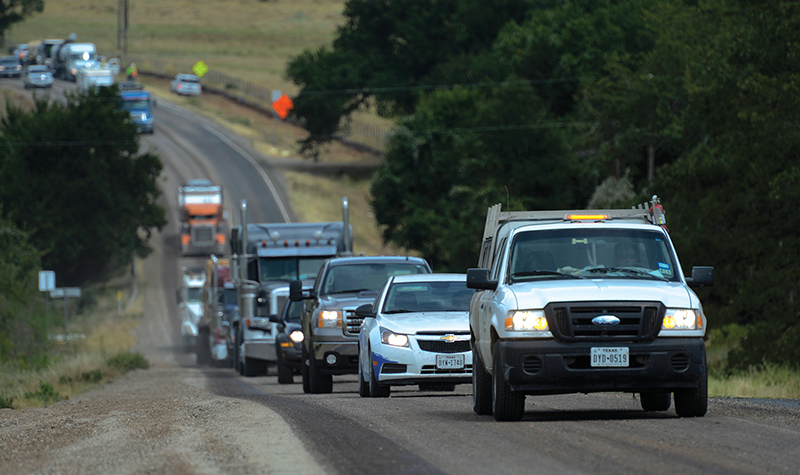
What is Traffic Noise?
Highway traffic noise refers to the sounds generated by vehicles traveling on highways. This noise typically includes:
Engine Sounds: The noise produced by car engines, which varies depending on the type and condition of the engine.
Tire Noise: The sound of tires rolling over the pavement, which can be affected by road surface and tire type.
Road Surface Noise: Noise created by the interaction between tires and the road surface, with different types of surfaces producing varying levels of sound.
Wind and Airborne Noise: The noise caused by air turbulence around moving vehicles.
Highway traffic noise can be a significant environmental concern, particularly for people living near busy roads. It can impact health and well-being, contributing to stress, sleep disturbances, and potential hearing issues. Efforts to mitigate traffic noise include sound barriers, road surface improvements, and vehicle noise regulations.
How is Traffic Noise Dangerous to Our Health?
Increased traffic noise had a detrimental effect on the quality of life.
Physically:
Heart Attacks (72% increased risk) - News Source and Scientific Source
Stroke - News Source and Scientific Source
High Blood Pressure - News Source and Scientific Source
Diabetes - News Source and Scientific Source
Hearing Loss (Hearing loss starts at 70dBA. Road noise is 70-90dBA) - News Source and Scientific Source and ASHA
Dementia - News Source and Scientific Source
Stress - News Source and Scientific Source
Infertility - News Source and Scientific Source
Obesity -
Mental and Cognative:
Suicide - News Source and Scientific Source
Anxiety - News Source and Scientific Source
Depression - News Source and Scientific Source
Bipolar - News Source and Scientific Source
Sleep Disturbances - News Source and Scientific Source
Behavioral Problems - News Source and Scientific Source
Focus - News Source and Scientific Source
Child Development:
Cognative Delays - News Source and Scientific Source
Developmental Delays - News Source and Scientific Source
Behavioral Problems - News Source and Scientific Source
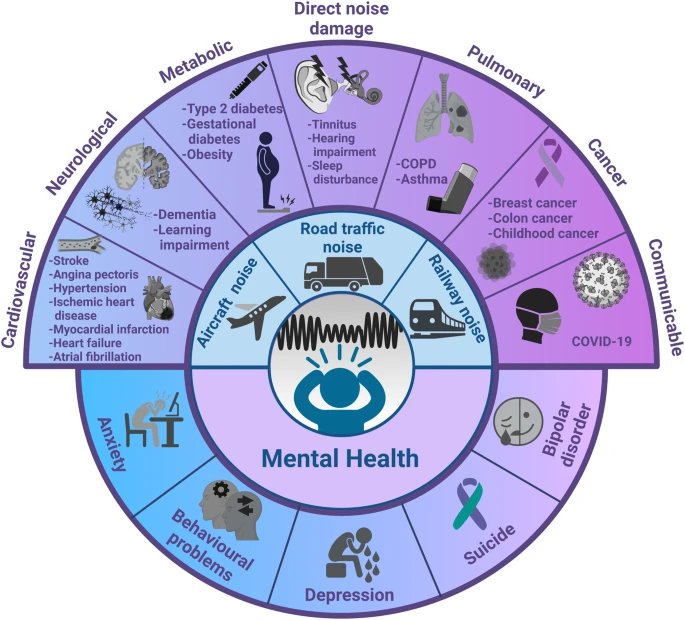
Noise from different sources was previously shown to likely affect different organ systems and promote a wide variety of diseases. Detrimental effects of noise can also play a prominent role in onset and progression of many aspects of mental health, like anxiety and depression. Source: Noise and mental health: evidence, mechanisms, and consequences (Jan. 2024 Peer Reviewed Paper)
What do Federal and State Regulations say about Noise?
While the federal government sets minimum standards that must be met it largely leaves it up to each state as to how to implement regulations. These regulations can be found at:
Federally: Title 23 Part 772
Minnesota: Chapter 7030
The first step in identifying noise impacts is to study them. Noise impacts are significant when there is a change of 5 decibels or more. A highway located in close proximity to homes will inevitably cause a change of at least 5 decibels, making it essential to implement mitigation measures to ensure the safety and well-being of residents.
What are Typical Noise Levels?
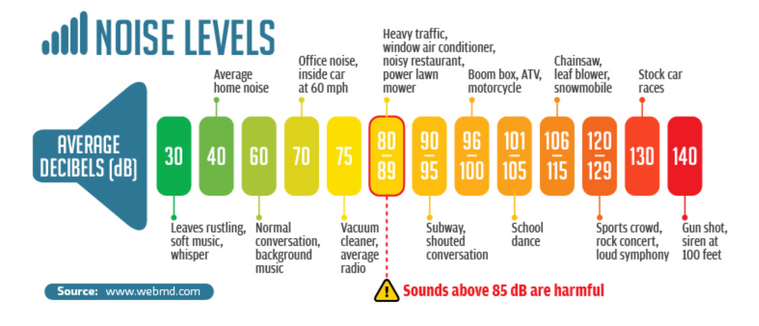
What does Minnesota say are Safe Noise Levels?
Imagine you're at home in your neighborhood (Noise Area Classification 1), and you want it to be peaceful. Think of sound as if it were a volume knob on a radio.
During the day: The rules say that for most of the time (30 minutes every hour), the sound in your neighborhood should be as quiet as a calm conversation (about 60 decibels). For a little while (no more than 6 minutes an hour), it can get a bit louder (65 decibels), but not more than 10 minutes cumulative.
At night: When everyone is trying to sleep, the rules are even stricter. Most of the time, the sound should be very quiet, like a whisper (50 decibels), and only for a short time (6 minutes an hour) can it be a bit louder, like soft talking (55 decibels).
Traffic noise: Cars and trucks on the road are much louder (70-90 decibels). That's why it's important to have rules to keep the neighborhood quieter, especially at night, so people can sleep well.

How can we reduce Noise Impacts when building a new Roadway?
The federal governments says first step is to study the impacts on all routes being proposed, to identify any impact. (23 CFR 772.11(c)(1))
Avoid, Minimize, Mitigate
Federal noise regulations follow a three-step approach to manage road noise:
Avoid: When planning new roads, the goal is to place them away from homes, schools, and hospitals to prevent noise issues from arising. This proactive strategy is more cost-effective and aims to eliminate potential noise impacts from the outset.
Minimize: If it's not feasible to avoid noise-sensitive areas, measures are implemented to reduce noise levels. This can include constructing homes with living spaces oriented away from roads, incorporating thicker walls, and adding more insulation to buffer against external noise. However, in cases where homes are already built, this is deemed unfeasible.
Mitigate: When noise cannot be sufficiently avoided or minimized, mitigation strategies are applied, such as constructing noise barriers or berms to lessen the impact on nearby communities. These structures serve to block or absorb sound, thereby reducing noise levels experienced by residents.
This structured approach ensures that efforts are made first to prevent noise, then to reduce it, and finally to mitigate its effects on people, promoting a quieter and healthier environment.
How Far Should New Roads Be from Residential Areas to Avoid Unsafe Noise Levels?
Understanding how far you need to be from different types of vehicles to experience a daytime noise level of 60 decibels (dB) is essential for effective planning and noise mitigation. Previous iterations of this plan accounted for a minimum distance of 800-1200 feet. Here's a breakdown based on vehicle type and speed per Minnesota Rules:
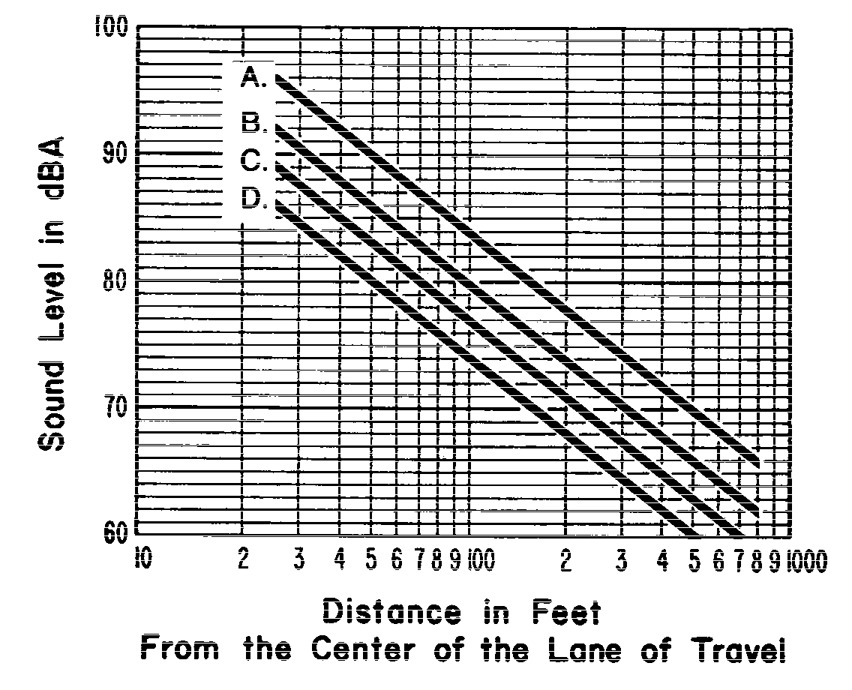
Trucks over 10,000lbs
Line A indicates speed limits above 35 mph. To maintain safe noise levels of 60 decibels during the day, a distance of over 1,000 feet is required.

Motorcycles
Line B represents motorcycles built after 1975 with speed limits greater than 35 mph. To achieve safe noise levels of 60 decibels during the day, an 800-foot separation is required.
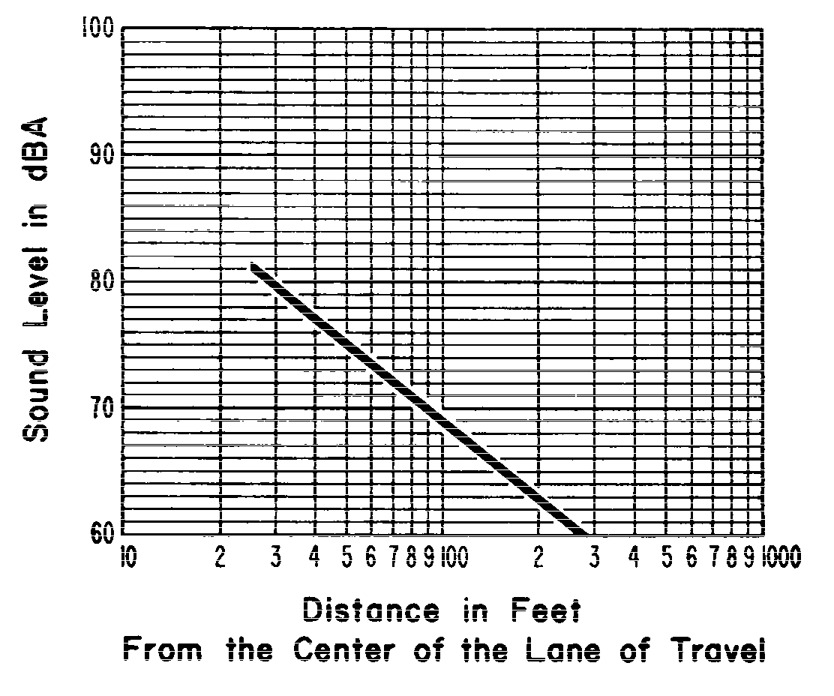
Personal Vechicles
This represents the majority of vehicles. Achieving safe noise levels of 60 decibels during the day requires a 300-foot separation.
What Defines a Truck Over 10,000 lbs and Why It Requires More Space?
Trucks need more space because they're bigger and heavier than regular cars, so they make more noise when they drive. Their engines, tires, and the weight they carry all create louder sounds, especially at higher speeds. The sound from trucks travels farther than the noise from smaller vehicles. That's why you need more distance to keep the noise levels safe and avoid disturbing people who live nearby. From heavy-duty pick-up trucks to buses to semis; here are the classifications of trucks:
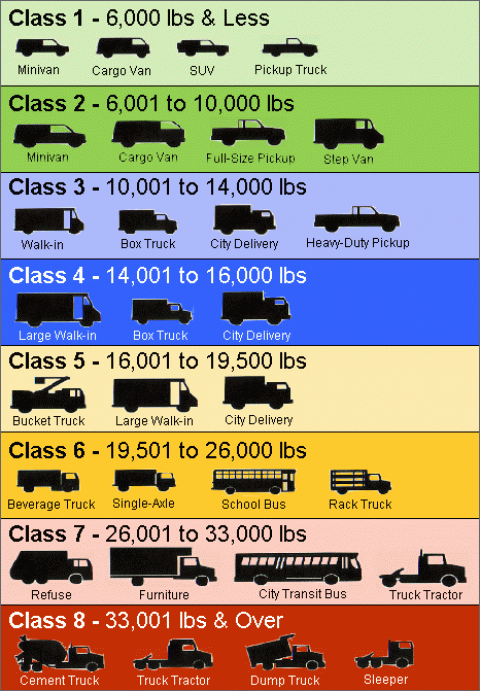
How Can Highway Noise Impact Be Minimized for Existing Homes?
To reduce highway noise, a house can be designed with several strategies, such as placing living spaces (like bedrooms) away from the side facing the highway, using thicker, soundproof windows, and installing acoustic insulation in walls. Additionally, using materials that absorb sound, such as soundproof drywall or special siding, can help block out noise. These adjustments help create a quieter and more comfortable living environment.
Since the houses are already built, it’s not feasible to make structural changes like repositioning rooms or installing new insulation to reduce highway noise. The only options are external solutions, such as avoidance and noise barriers, to minimize the impact of highway noise.
What Are the Options for Mitigating Traffic Noise Near Residential Areas?
Noise Wall: The federal government mandates that highway agencies must consider noise abatement, including the use of noise barriers or walls. These barriers can reduce traffic noise by deflecting or absorbing sound. Any project that will change the sound levels by 5 decible or
Berms: While berms can be an effective mitigation method, they require a 1:6 ratio – meaning for every foot of height, six feet of distance is needed. Unfortunately, the 100-foot mapped right of way doesn't provide enough space to construct a berm that would meet Minnesota’s regulations. Additionally, berms create drainage issues by directing water onto residential properties, necessitating drainage systems.
Mature Trees: Planting trees can help reduce traffic noise, but there is insufficient space to plant the dense, large evergreen trees needed for significant noise reduction. A buffer of at least 100 feet with trees over 15 feet tall would be required. Moreover, maintaining trees to keep them effective in reducing noise is challenging, as MnDOT lacks the resources for long-term maintenance of vegetation.
These options highlight the limitations and challenges of effectively mitigating traffic noise in certain residential areas.
What are noise walls and how do they work?
Who Decides If a Noise Wall Should Be Built?
Residents of the North Country Subdivision.
In Minnesota, the decision to build a noise wall is made through a voting process in which the most impacted residents participate. While no one wants a noise wall, residents are prepared to vote in favor of one due to the limited 17-foot distance between some homes and the right of way in our neighborhood. If the East Side Corridor (ESC) is built at the 29th Ave location, a noise wall is the only option to ensure safety and protect residents from the impact of noise.
Is a Noise Wall Feasible & Reasonable?
A noise wall at the 29th Ave location is both feasible and reasonable. There is nothing physically preventing its construction, and it would provide a 5 dBA noise reduction for 37 residential properties, with 18 homes receiving at least a 7 dBA reduction, making it feasible. The estimated total cost of $2.3 million is below the 2023 allotted amount of $78,500 per benefited receptor, making it reasonable. Given the 17-foot proximity of homes to the right of way, the significant noise impacts, and the reduced size of the right of way, a noise wall remains the only effective solution to mitigate noise and ensure safety for residents.
Avoidance is almost always a more cost effective solution.
How Much Will a Noise Wall Cost?
Noise walls comparable to the one needed for the 29th Ave option are listed on MnDOT’s website at $2.5 million. For the first time, the City, County, and WSB acknowledged in the memorandum released on September 23, 2024, that residents are entitled to a noise wall. The final page of this document showed an estimated cost of $2.3 million for the noise wall at the 29th Ave location, which aligns with concerns voiced by residents over the past year. The memorandum also highlighted the need for urban roadway design to reduce speeds in theses areas, adding an additional $7.8 million in tax dollars to the overall cost. However, these costs can be prevented if the avoidance strategies recommended by the FHWA, MnDOT, and earlier project plans are followed.
Avoidance is almost always a more cost effective solution.
Are There Safer, More Cost-Effective Options?
Yes, there are alternative options that could be more cost-effective and safer! Avoidance is always a more cost-effective solution. Residents have proposed two much more affordable alternatives:
34th Ave – This is an existing minimum maintenance road. Steele County owns a 66-foot right of way along this route, totaling 18 acres. While the memorandum did not support the near-term use of this route, future developments stand to benefit the most from this alternative as part of the East Side Corridor.
Hybrid Alternative – This option combines Alternative 4 on the north and Alternative 3 on the south, aligning with avoidance while being in close proximity to the city limits. The memorandum highlighted that Alternatives 2-4 achieve the same goals. While it offers some immediate benefits, the biggest advantages will come from future developments.
How Can You Help Influence This?
Visit our "How to Help" page to reach out to elected officials. Attend meetings and voice your concerns, but most importantly, attend the next open house and submit all your comments, asking for more cost-effective, future-focused plans to be considered!
Had reasonable avoidance options been considered from the beginning, as residents have advocated since day one, this project would already be in the building phase. Instead, we are spending extra money to come to the same conclusions residents have been voicing for more than 3 decades!
The East Side Corridor is the single most important project for shaping Steele County. Let's do it right—prioritizing safety and fiscal responsibility!